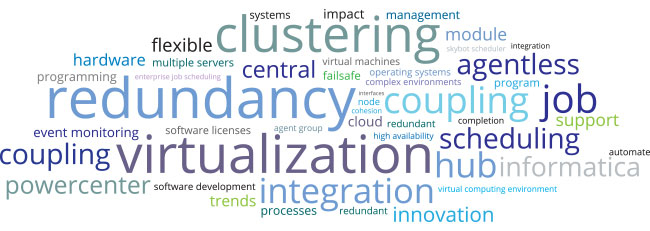Key Terms to Understand Enterprise Job Scheduling

No one likes to be out of the loop. We’re glued to our smartphones because the generation in which we live—no matter your age—moves information at a faster pace than ever before. Whether at work or at play, you probably use your web browser or mobile apps for social media and news to access live updates multiple times a day. Being late to the information game simply isn’t an option in the 21st-century.
So we’re here to help. We’ve compiled a list of key buzzwords in the IT industry to make sure you’re up to date on current discussion points, especially as they relate to enterprise job scheduling. You’ll be equipped to discuss important trends and changes in the IT environment as well as to discern certain features of job scheduling software to help you make the right decision for automating your organization.
Coupling
Coupling is the degree to which elements of a module belong together, and it is an important concept for the design of software. Coupling contrasts with the concept of cohesion, such that low coupling equals high cohesion, and vice versa.
In more simple language, coupling is the relationship between two pieces of code, like the way in which an agent and server are coupled.
Redundancy and Clustering
In modern, complex IT environments where system outages can be disastrous to a company’s budget, reputation, and customer service, redundancy is a key strategy for any organization. Redundancy means setting up a redundant—or high availability—server that acts as a backup server if your main system goes down.
More specifically, clustering is a particular method for dealing with redundancy. The ability to create agent groups within JAMS provides a form of clustering. When you set up an agent group, you indicate that JAMS can run a certain job on any one of a group of servers. In this way, there is a failsafe method for the job to complete on multiple possible servers in case one of the servers goes down.
Virtualization and the Cloud
A virtual computing environment is one in which processes can be allocated from one place to another, which allows you to be flexible with your business processes. The benefit of virtualization is that, though your operating system thinks it’s running on hardware, there is no distinct motherboard that could fail or cause a problem for your virtualized processes.
The trend toward virtualization is more about attitude than anything else: the willingness to allocate resources in different ways. The simple benefit to virtualization is that you won’t have software licenses that you don’t need and you won’t be bogged down with excessive hardware. With no need to maintain hardware, running virtual machines in the cloud allows your business to grow quickly.
Agentless Job Scheduling
Agentless job scheduling is a newer concept being introduced in the job scheduling world. There are both advantages and disadvantages to using a central scheduler with no agent to run your jobs.
The two models for scheduling with or without agents can be simplified to the following, respectively: you’re either running a lot of jobs on a few computers—a case for job scheduling with agents—or you’re running a few jobs on a lot of computers—a case for agentless job scheduling.
Agentless scheduling requires less management work because you do not have to maintain software on every box on which you want to run jobs. In turn, this saves you money and there is less of an impact on the performance of your systems. In contrast, when agents are running full time, there is more of an impact on the system than if you just log in every once in a while to check your few jobs.
However, there are significant advantages to continuing to use agents for enterprise job scheduling. Scheduling with agents bolsters error recovery on your servers because you’re running software on every box and therefore have more real-time knowledge of network events. Even if you incur a network problem, with an agent, you know your job runs until completion and you can store your data.
Integration Hub
The term integration hub refers to the architecture of the system. An integration hub hides the complexity of your system, which is also known as encapsulating. Essentially, the hub is the central point that manages and communicates between systems so that systems don’t have to know about each other. This type of architecture prevents coupling and is intended for largely scalable environments.
JAMS is an integration hub in that it acts as a go-between for your agents and servers. If a file arrives on a server via an agent, JAMS is alerted and knows where to dictate the next movement of that file.
Because of the speed of both information transfer as well as innovation in the IT industry, important buzzwords right now will become part of the foundation of the enterprise job scheduling industry sooner rather than later. Keep these phrases in mind as you continue to innovate your organization and perhaps look to automate your enterprise with a job scheduling tool.